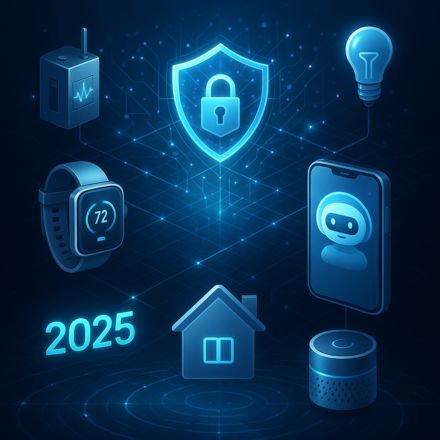
The Internet of Things (IoT) is no longer a futuristic concept—it’s now the digital backbone of our smart homes, industrial operations, healthcare systems, and city infrastructure. With over 27 billion IoT devices expected to be online by 2025, the volume of sensitive data being generated, processed, and transmitted will be staggering. But with this explosion of connectivity comes a rising concern: how do we ensure IoT data security and connected device safety in an increasingly complex digital world?
As 2025 approaches, safeguarding IoT ecosystems is no longer a nice-to-have—it’s a critical necessity. This article explores the key vulnerabilities, emerging threats, and the strategic measures businesses and individuals must adopt to ensure that connected doesn’t mean compromised.
The Growing Importance of IoT Data Security
Every smart sensor, wearable device, or connected appliance is a data point in a massive web of communication. These devices gather and share real-time data—everything from personal health metrics and location tracking to industrial machine readings and energy consumption.
While this connectivity brings immense value, it also introduces new risks. Unlike traditional IT systems, many IoT devices have limited processing power, outdated firmware, and lack standardized security protocols. These vulnerabilities make them attractive targets for cybercriminals looking to exploit data or disrupt services.
In 2025, IoT data security will be at the forefront of digital transformation strategies, as organizations realize that without trust and protection, innovation cannot scale.
Top Threats to Connected Device Safety in 2025
Securing IoT systems requires understanding the evolving threat landscape. Here are some of the top challenges for connected device safety in the coming year:
1. Device Hijacking
Attackers can take control of poorly secured devices and use them for malicious purposes—like launching DDoS attacks or spying on users. In 2025, as more critical systems (like traffic controls or medical devices) go online, the consequences of hijacking become more severe.
2. Data Interception
Unencrypted communications between devices and servers can be intercepted, allowing hackers to steal sensitive information such as passwords, health records, or location data.
3. Firmware Exploits
Many IoT devices aren’t regularly updated, leaving firmware vulnerabilities wide open for exploitation. As the number of devices grows, so does the challenge of maintaining timely updates.
4. Botnet Formation
Infected IoT devices can be grouped into botnets—networks of compromised machines used to perform automated cyberattacks, often without the device owner’s knowledge.
Best Practices to Safeguard IoT Data in 2025
Securing your IoT infrastructure requires a combination of smart design, proactive management, and user education. Here are the top IoT data security practices for 2025:
1. Implement End-to-End Encryption
All data transferred between devices, apps, and cloud services must be encrypted using lightweight protocols suitable for low-power devices. This ensures that even if intercepted, data cannot be read or misused.
2. Secure Device Authentication
Only authorized devices should be able to access a network. Strong authentication methods—like unique device IDs, digital certificates, or multi-factor authentication—should be enforced across all endpoints.
3. Regular Firmware and Software Updates
Automated update systems ensure that devices receive critical patches without requiring manual intervention. Manufacturers should adopt a “security by design” approach, with built-in support for future updates.
4. Adopt a Zero Trust Model
In a Zero Trust architecture, no device or user is automatically trusted. Continuous verification and role-based access control help reduce the risk of lateral attacks within a network.
5. Use AI and Machine Learning for Threat Detection
AI-based monitoring tools can analyze vast volumes of data to detect anomalies or signs of suspicious activity in real time, giving security teams a much-needed edge against sophisticated attacks.
The Role of Standards and Regulation
To ensure universal connected device safety, regulatory bodies across the globe are stepping in with mandates aimed at improving IoT security. The European Union’s Cyber Resilience Act and the U.S. IoT Cybersecurity Improvement Act are just the beginning. These regulations are pushing manufacturers to implement standardized security features such as:
-
Unique default credentials
-
Transparent data usage policies
-
Update support lifecycles
-
Built-in encryption capabilities
In 2025, compliance with such standards won’t just be about avoiding penalties—it will be key to maintaining consumer trust and market reputation.
What Businesses Should Do Now
To prepare for 2025 and beyond, organizations must:
-
Conduct a comprehensive security audit of all IoT assets
-
Segment IoT networks from primary IT infrastructure
-
Partner with vendors that prioritize security and offer long-term update support
-
Train staff and users on security best practices
-
Stay informed on evolving threats and regulatory changes
By taking these steps, businesses can transform IoT from a security liability into a competitive advantage.
Conclusion: Building a Safer Connected Future
As IoT devices become more embedded in our lives, protecting the data they handle becomes paramount. From personal wearables to smart factories, IoT data security and connected device safety will shape the success of digital transformation in 2025.
Securing the future doesn’t mean slowing innovation—it means building a smarter, safer, and more trustworthy connected world. Whether you’re a manufacturer, business leader, or everyday user, taking security seriously today is the best way to unlock IoT’s full potential tomorrow.